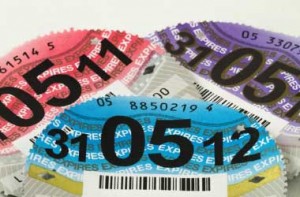Car tax bands (also referred to as road tax and formerly known as Vehcle Excise duty) are currently based on your vehicles carbon dioxide (CO2) emissions. Cars and light goods vehicles registered before March 2001 have their vehicle tax rates based on the size of the engine.
- Vehicle Tax bands pre March 2001
- New vehicle tax rates
- Vehicle tax bands since March 2001
- Tax disc abolition
- Dirty diesel tax for UK cities
- Car tax bands – consider when purchasing
Vehicle tax bands pre March 2001
- Vehicles up to 1549cc – 6 months £79.75 / 12 months £145
- Vehicles over 1549cc – 6 months £126.50 / 12 months £230
With the ever-growing awareness of the environmental impact of vehicle CO2 emissions on the environment, car tax bands were divided into thirteen categories based on the level of CO2 emissions from the vehicle. The vehicle tax bands have been differentiated by letter, with tax band A being the lowest emission vehicles with the lowest yearly tax rate. Tax band M refers to the highest level of tax with a vehicle’s emissions over 255 g/km of CO2 emissions. So your choice of vehicle can make a big difference to your yearly motoring costs depending on its car tax band.
New vehicle tax rates
All new vehicles with a tax band of A to D will enjoy a zero tax rate for the first year the vehicle is on the road. Vehicles in the tax bands E to G will pay the same tax rate for their first year on the road as their standard annual road tax. For all vehicles which are purchased in tax band categories H to M, you will be paying more for your first year’s road tax than your standard yearly road tax which it will reduce back to for year 2 and subsequent years after that.
Electric, alternative fuelled cars, hybrids and LPG vehicles can also enjoy a £10 reduction on both the first year’s tax and the standard yearly rate thereafter.
Vehicle tax bands since March 1st 2001
| VED Band | Vehicle CO2 Emissions | Standard rate Petrol/Diesel | First year rate Petrol/Diesel | Standard rate Green car | First year rate Green car |
|---|---|---|---|---|---|
| A | Up to 11g/km | £0 | £0 | £0 | £0 |
| B | 101 – 110g/km | £20 | £0 | £10 | £0 |
| C | 111-120g/km | £30 | £0 | £20 | £0 |
| D | 121-130g/km | £110 | £0 | £100 | £0 |
| E | 131-140g/km | £130 | £130 | £120 | £120 |
| F | 141-150g/km | £145 | £145 | £135 | £135 |
| G | 151-165g/km | £180 | £180 | £170 | £170 |
| H | 166-175g/km | £205 | £290 | £195 | £280 |
| I | 176-185g/km | £225 | £345 | £215 | £335 |
| J | 186-200g/km | £265 | £485 | £255 | £475 |
| K | 201-225g/km | £285 | £635 | £275 | £625 |
| L | 226-255g/km | £485 | £860 | £475 | £850 |
| M | Over 255g/km | £500 | £1090 | £490 | £1080 |
Tax disc abolition
The law is changing in 2014 to reduce the administration costs associated with vehicle tax. From the 1st October 2014, the paper tax disc will no longer be issued or required to be displayed in the vehicle windscreen. The tax disc has been a familiar site on the UK’s roads with the first vehicle tax disc being issued on 1st January 1921.
With the advancements in technology including automatic number plate readers and with the readily available database to the police, the tax disc is no longer required to be displayed in vehicles’ windows. Motorists will also have the option to pay their road tax by direct debit annually, biannually or monthly. Monthly and biannually payments will see a surcharge of 5% which is half of the previous surcharge for biannual payments.
Dirty diesel tax for UK cities
With the ever-growing popularity of diesel cars (a nearly four fold increase between 2000 to 2014 with 11 million on now on the road), introducing the proposed £10 charge for the Ultra Low Emission Zone (ULEZ) would affect a large amount of UK drivers who wish to drive into London and other major cities if they follow suit.
What is this new proposed city diesel tax for the Ultra Low Emission Zone (ULEZ), how does it work?
The plans are still in the early stages, but early signs are that from 2020 Boris Johnson would like to see all diesel and petrol cars registered before 2006 paying an extra £10 to drive into central London on top of the excisitng congestion charge. Only vehicles that meet Euro 6 emissions standard would be exempt from the charge. Check out the full list of the Euro rating standards on emissions. Boris Johnson is outlaying plans for an “air quality manifesto” to bring down London’s air pollution levels to within two-thirds of the way down towards the limits set by the EU.
Car tax bands – consider when purchasing
When purchasing a new vehicle that’s been registered after March 2001, considering the vehicle’s emissions can make a massive difference to your yearly running costs. A vehicle with emissions up to 100g/km CO2 will enjoy tax-free motoring, whilst if you purchase a vehicle at the other end of the emission scale with over 255g/km CO2, you can expect a £500 a year tax bill, this equates to an additional £41.67 per month on top of your monthly fuel bill, which can make a quite a difference to your monthly expenses! The full car tax bands table can be found below.